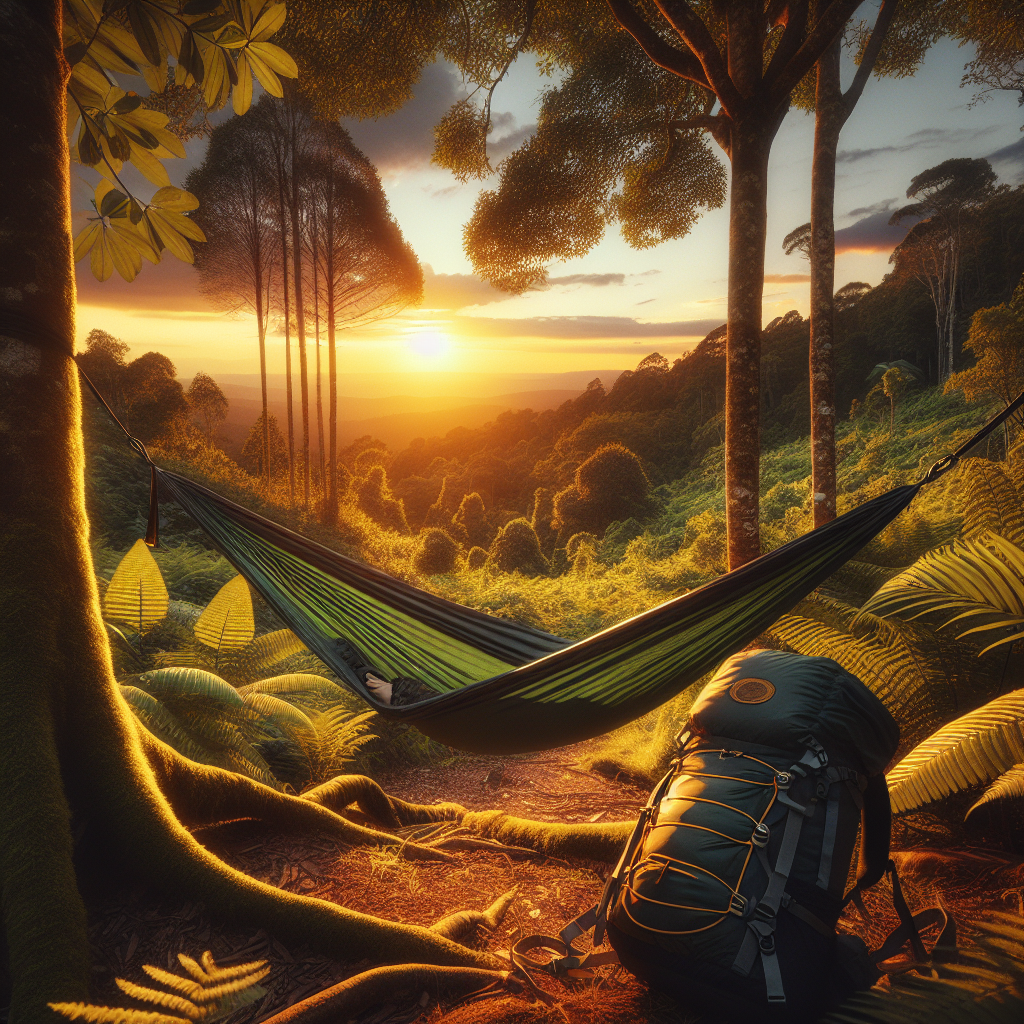Get ready to embark on a journey that promises both comfort and thrill as you explore the wonders of Hammock camping. This thrilling activity combines the peaceful solitude of the great outdoors with the homely comfort of a hammock, creating a unique and immersive experience that you won’t forget easily. As you read through this article, you’ll find that hammock camping is not just about defying the challenges of the wild but also about reveling in its serene beauty with utmost convenience. Prepare to be fascinated as you find out more about how hammock camping can heighten your passion for adventure while ensuring your comfort. So, grab your gear and get ready to swing into action!

Understanding Hammock Camping
Hammock camping is an innovative form of outdoor adventure that is gaining popularity. It involves swapping your traditional camping tent for a hammock suspended between two trees or posts. It’s a unique, fun, and surprisingly comfortable way to experience the great outdoors.
Concept of Hammock Camping
Hammock camping, to put it simply, is camping with a hammock instead of a tent. This camping style is particularly favored by lightweight hikers and backpackers due to its simplicity and minimal gear requirements. With a hammock, you simply find two appropriately spaced trees or sturdy posts, hang your hammock, and you have your overnight lodging in nature sorted.
Advantages of Hammock Camping
There are several major advantages to hammock camping. First, it allows better air circulation which keeps you cooler on warm nights. Second, sleeping in a hammock can be surprisingly comfortable, as it conforms to your body shape, providing stunning back support. Third, Hammock camping leaves no trace on the ground and does not require leveling or clearing an area before setting up. Additionally, it’s ultra-portable and lightweight which is great for backpacking.
Who is Hammock Camping for?
Hammock camping suits every outdoors enthusiast who seeks a different kind of camping experience. It’s especially enjoyed by minimalist backpackers, thru-hikers, and anyone who loves lounging in a cozy hammock while soaking in the natural surrounding.
Different Types of Camping Hammocks
Just like tents, not every hammock is created equal. There are various types of camping hammocks to choose from, each with its unique features, pros, and cons.
Regular Camping Hammock
Regular camping hammocks are your basic hammocks. They’re lightweight, easy to set up, and perfect for short camping trips, lounging in a park, or even in your backyard. Do keep in mind, they may lack some advanced features you would prefer for long-term camping.
Ultralight Hammocks
As the name suggests, ultralight hammocks are about shedding weight for lightweight hiking. They’re typically constructed from thin, lightweight material, providing a perfect balance between comfort, weight, and strength.
Expedition Hammocks
Designed for long-term, multi-day trips, expedition hammocks come equipped with advanced features like bug nets, strong suspension systems, and larger weight capacities. They’re more durable and weather-resistant to handle harsh outdoor conditions.
Double Hammocks
Ideal for those who like space or camping as a couple, double hammocks offer a wider and stronger platform. They usually come with a higher weight limit and provide ample space for two people or one person who needs extra room.
Choosing the Right Hammock for Camping
Choosing the right hammock can dictate the success of your hammock camping trip. It requires understanding your needs and considering a few key aspects such as size, weight, material, and set-up.
Size and Weight Considerations
Size and weight play a crucial role in how comfortable you’ll be and how easy your hammock will be to carry. Tall and hefty campers may require a larger hammock, whereas a solo lightweight hiker might opt for a smaller, light hammock.
Material and Durability
The material dictates both the comfort and durability of a hammock. While nylon hammocks are durable and weather-resistant, cotton ones are more comfortable but less suitable for camping due to their heavier weight and long drying time.
Ease of Set-up
The ease of a hammock set up can make a significant difference in your camping experience. Look for hammocks with simple, straightforward set-up processes and strong, adjustable straps for hanging.
Essential Hammock Camping Gear
Aside from a hammock, a few other pieces of gear are essential for successful hammock camping.
Hammock Straps and Suspension Systems
Hammock straps and suspension systems are what you use to hang your hammock. They need to be strong, durable, and easily adjustable so you can find the optimum hang angle.
Hammock Tarps for Weather Protection
A hammock tarp, also known as a rainfly, provides shelter from rain and shade from the sun. It’s an essential piece of gear for staying dry and comfortable in all weather conditions.
Underquilts and Sleeping Pads for Insulation
Hammocks can get cold, even on warmer nights. Underquilts and sleeping pads add insulation, trapping heat, and keeping you warm throughout the night.

Setting Up Your Hammock For Camping
When it comes to hammock camping, set up is key. It boils down to finding a good camping site, hanging your hammock correctly, and setting up your tarp and guy-lines.
Selecting a Good Camping Site
A good camping site isn’t just about the view. You have to find two trees that are sturdy and spaced ideally 10 to 15 feet apart. They should be healthy and devoid of dead branches that might fall.
Hanging Your Hammock at the Correct Height and Angle
Hammocks should be hung at a height and angle that’s comfortable for you to climb in and out of. A good rule of thumb is to hang your hammock with a sag angle of about 30 degrees for optimum comfort.
Tarp and Guy-line Setup
Setting up your tarp correctly is essential for weather protection. Ensure it pitches tightly and covers the whole hammock. Guy-lines should be used to anchor your tarp in windy conditions.
Staying Safe and Comfortable in a Hammock
Safety should be your top priority when hammock camping.
Securing Your Hammock Properly
Always double-check your hammock’s straps and suspension systems to ensure they’re secured properly. A well-hung hammock not only provides comfort but also prevents accidents.
Using Bug Nets and Rainflies
Bug nets keep mosquitoes and other insects away, ensuring a good night’s sleep. Rainflies provide shelter from rain and sun, enhancing your comfort and safety.
Layering for Warmth and Comfort
Layering is crucial in hammock camping. use sleeping pads or underquilts for bottom insulation. Layer up with warm clothes during chilly weather and adjust accordingly as the temperature changes.
Hammock Camping in Different Weather Conditions
Experiencing different weather conditions is part of the charm in hammock camping.
Hammock Camping in Snow
When camping in snow, make sure to have proper insulation like underquilts and top quilts. A tarp with doors can add extra protection against cold gusts of wind.
Camping in Rain
A good rainfly is necessary for camping in rain. Place it above your hammock to shed water away. Always check for potential water runoff when picking a site to avoid being in a water pathway.
Handling Wind While Hammock Camping
In windy conditions, pitch your tarp low and at an angle against the wind to reduce exposure. Use guy-lines to secure the tarp and weight down the edges if necessary.
Environmental Considerations and Leave No Trace Principles
As a responsible camper, always be respectful of the environment and adhere to the Leave No Trace Principles.
Minimizing Impact on Environment
Use designed hammock straps that prevent damage to bark and don’t hang your hammock on young or small trees. Avoid altering the site by clearing vegetation or moving rocks.
Respecting Wildlife and Others
Maintain a safe distance from wildlife and keep your food secure. Respect other campers’ peace and quiet, and avoid camping close to trails or water sources.
Practicing Fire Safety
Make sure fires are permitted before lighting one. Use fire rings or mounds, and put out fires completely before leaving. Be sure to pack out all trash and leftover food.
Common Mistakes in Hammock Camping
Avoid making these common mistakes for an enjoyable hammock camping experience.
Choosing Wrong Trees
The wrong trees can make hanging a hammock impossible or unsafe. Always select healthy, robust trees that have the appropriate distance between them.
Ignoring Weather Forecast
Not paying attention to the weather forecast can leave you unprepared for adverse conditions. Always check the forecast and plan your gear accordingly.
Avoiding Inadequate Insulation
Hammock campers often forget how chilly it can get while suspended in the air. Never skimp on insulation. Use underquilts, sleeping pads, and proper clothing to stay warm.
Advanced Tips For Hammock Camping
Bear these advanced tips in mind for a more satisfying hammock camping experience.
Mastering The Perfect Hang
Practice makes perfect! The best way to ensure comfort is by practicing your hang. Over time, you’ll discover the best hanging methods and fine-tune adjustments that work best for you.
Multi-day Hammock Camping
If you’re embarking on a multi-day hiking trip, consider a more robust camping hammock which includes features for protection against varied elements.
Hammock Camping with Kids
Introduce kids to hammock camping by starting with backyard trials. Equip them with headlamps for nighttime convenience, rainflies for weather protection, and ensure their hammock is of the correct size and hang height for safety.
In the end, hammock camping is all about striking the balance between comfort and convenience, safety, and respect for nature. Whether you’re a seasoned backpacker or a casual camper, embracing the hammock camping adventure is an experience worth trying. Happy Hammocking!

